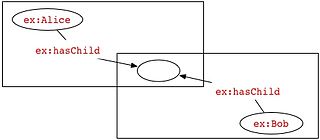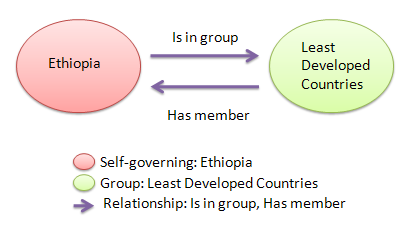
The Semantic Web, sometimes known as Web 3.0, is an extension of the World Wide Web through standards set by the World Wide Web Consortium (W3C). The goal of the Semantic Web is to make Internet data machine-readable.
The Resource Description Framework (RDF) is a method to describe and exchange graph data. It was originally designed as a data model for metadata by the World Wide Web Consortium (W3C). It provides a variety of syntax notations and data serialization formats, of which the most widely used is Turtle.

A topic map is a standard for the representation and interchange of knowledge, with an emphasis on the findability of information. Topic maps were originally developed in the late 1990s as a way to represent back-of-the-book index structures so that multiple indexes from different sources could be merged. However, the developers quickly realized that with a little additional generalization, they could create a meta-model with potentially far wider application. The ISO/IEC standard is formally known as ISO/IEC 13250:2003.
In computer science, reification is the process by which an abstract idea about a program is turned into an explicit data model or other object created in a programming language. A computable/addressable object—a resource—is created in a system as a proxy for a non computable/addressable object. By means of reification, something that was previously implicit, unexpressed, and possibly inexpressible is explicitly formulated and made available to conceptual manipulation. Informally, reification is often referred to as "making something a first-class citizen" within the scope of a particular system. Some aspect of a system can be reified at language design time, which is related to reflection in programming languages. It can be applied as a stepwise refinement at system design time. Reification is one of the most frequently used techniques of conceptual analysis and knowledge representation.
The Web Ontology Language (OWL) is a family of knowledge representation languages for authoring ontologies. Ontologies are a formal way to describe taxonomies and classification networks, essentially defining the structure of knowledge for various domains: the nouns representing classes of objects and the verbs representing relations between the objects.
RDF Schema (Resource Description Framework Schema, variously abbreviated as RDFS, RDF(S), RDF-S, or RDF/S) is a set of classes with certain properties using the RDF extensible knowledge representation data model, providing basic elements for the description of ontologies. It uses various forms of RDF vocabularies, intended to structure RDF resources. RDF and RDFS can be saved in a triplestore, then one can extract some knowledge from them using a query language, like SPARQL.
SPARQL is an RDF query language—that is, a semantic query language for databases—able to retrieve and manipulate data stored in Resource Description Framework (RDF) format. It was made a standard by the RDF Data Access Working Group (DAWG) of the World Wide Web Consortium, and is recognized as one of the key technologies of the semantic web. On 15 January 2008, SPARQL 1.0 was acknowledged by W3C as an official recommendation, and SPARQL 1.1 in March, 2013.

FOAF is a machine-readable ontology describing persons, their activities and their relations to other people and objects. Anyone can use FOAF to describe themselves. FOAF allows groups of people to describe social networks without the need for a centralised database.
A web resource is any identifiable resource present on or connected to the World Wide Web. Resources are identified using Uniform Resource Identifiers (URIs). In the Semantic Web, web resources and their semantic properties are described using the Resource Description Framework (RDF).
RDFa or Resource Description Framework in Attributes is a W3C Recommendation that adds a set of attribute-level extensions to HTML, XHTML and various XML-based document types for embedding rich metadata within Web documents. The Resource Description Framework (RDF) data-model mapping enables its use for embedding RDF subject-predicate-object expressions within XHTML documents. It also enables the extraction of RDF model triples by compliant user agents.
Simple Knowledge Organization System (SKOS) is a W3C recommendation designed for representation of thesauri, classification schemes, taxonomies, subject-heading systems, or any other type of structured controlled vocabulary. SKOS is part of the Semantic Web family of standards built upon RDF and RDFS, and its main objective is to enable easy publication and use of such vocabularies as linked data.
Agricultural Information Management Standards (AIMS) is a web site managed by the Food and Agriculture Organization of the United Nations (FAO) for accessing and discussing agricultural information management standards, tools and methodologies connecting information workers worldwide to build a global community of practice. Information management standards, tools and good practices can be found on AIMS:
Gellish is an ontology language for data storage and communication, designed and developed by Andries van Renssen since mid-1990s. It started out as an engineering modeling language but evolved into a universal and extendable conceptual data modeling language with general applications. Because it includes domain-specific terminology and definitions, it is also a semantic data modelling language and the Gellish modeling methodology is a member of the family of semantic modeling methodologies.

In RDF, a blank node is a node in an RDF graph representing a resource for which a URI or literal is not given. The resource represented by a blank node is also called an anonymous resource. According to the RDF standard a blank node can only be used as subject or object of an RDF triple.

In computing, linked data is structured data which is interlinked with other data so it becomes more useful through semantic queries. It builds upon standard Web technologies such as HTTP, RDF and URIs, but rather than using them to serve web pages only for human readers, it extends them to share information in a way that can be read automatically by computers. Part of the vision of linked data is for the Internet to become a global database.

GeoNames is a user-editable geographical database available and accessible through various web services, under a Creative Commons attribution license. The project was founded in late 2005.

In computer science, information science and systems engineering, ontology engineering is a field which studies the methods and methodologies for building ontologies, which encompasses a representation, formal naming and definition of the categories, properties and relations between the concepts, data and entities of a given domain of interest. In a broader sense, this field also includes a knowledge construction of the domain using formal ontology representations such as OWL/RDF. A large-scale representation of abstract concepts such as actions, time, physical objects and beliefs would be an example of ontological engineering. Ontology engineering is one of the areas of applied ontology, and can be seen as an application of philosophical ontology. Core ideas and objectives of ontology engineering are also central in conceptual modeling.
Knowledge extraction is the creation of knowledge from structured and unstructured sources. The resulting knowledge needs to be in a machine-readable and machine-interpretable format and must represent knowledge in a manner that facilitates inferencing. Although it is methodically similar to information extraction (NLP) and ETL, the main criterion is that the extraction result goes beyond the creation of structured information or the transformation into a relational schema. It requires either the reuse of existing formal knowledge or the generation of a schema based on the source data.
The European Legislation Identifier (ELI) ontology is a vocabulary for representing metadata about national and European Union (EU) legislation. It is designed to provide a standardized way to identify and describe the context and content of national or EU legislation, including its purpose, scope, relationships with other legislations and legal basis. This will guarantee easier identification, access, exchange and reuse of legislation for public authorities, professional users, academics and citizens. ELI paves the way for knowledge graphs, based on semantic web standards, of legal gazettes and official journals.
In natural language processing, linguistics, and neighboring fields, Linguistic Linked Open Data (LLOD) describes a method and an interdisciplinary community concerned with creating, sharing, and (re-)using language resources in accordance with Linked Data principles. The Linguistic Linked Open Data Cloud was conceived and is being maintained by the Open Linguistics Working Group (OWLG) of the Open Knowledge Foundation, but has been a point of focal activity for several W3C community groups, research projects, and infrastructure efforts since then.







